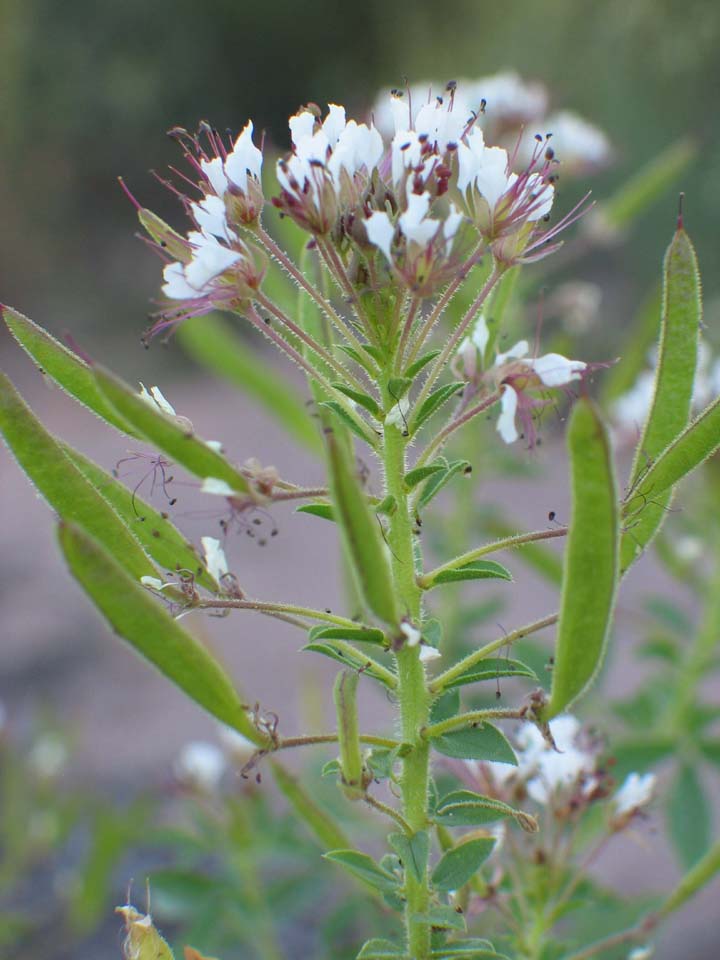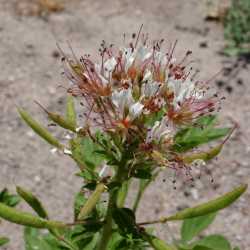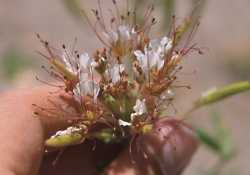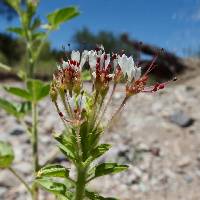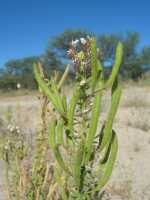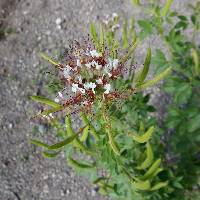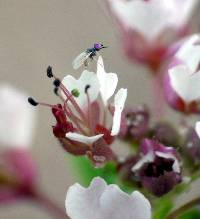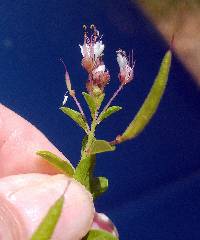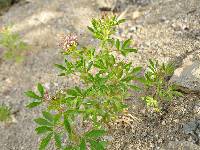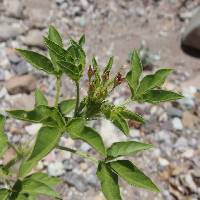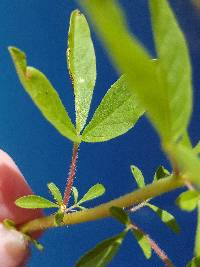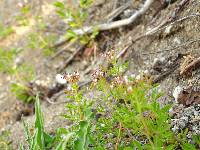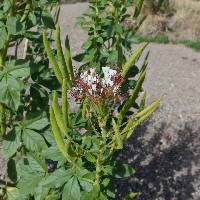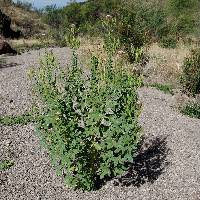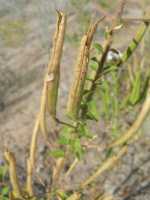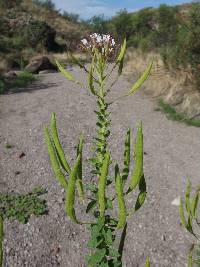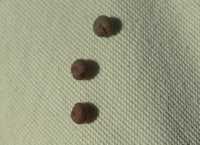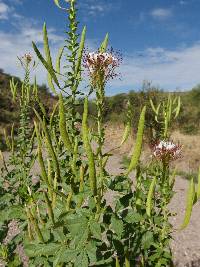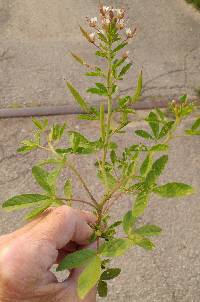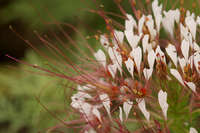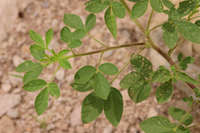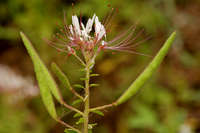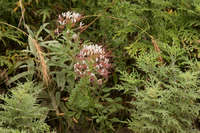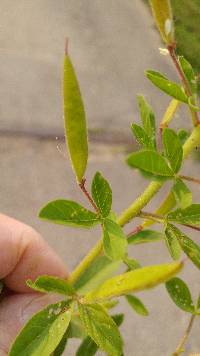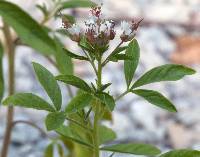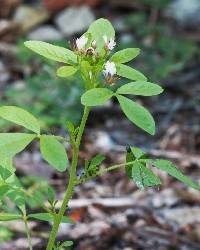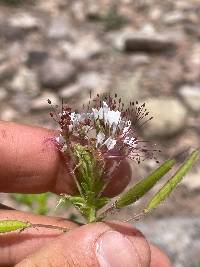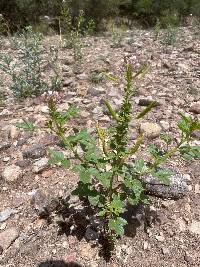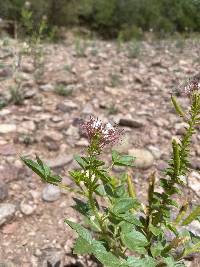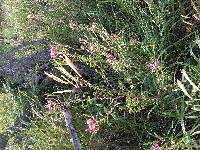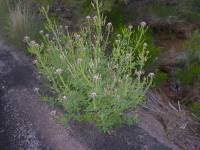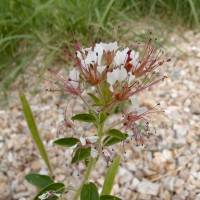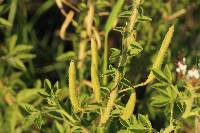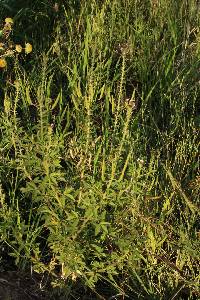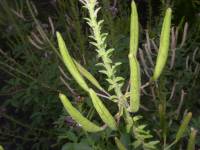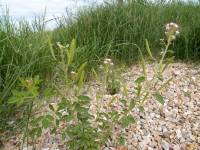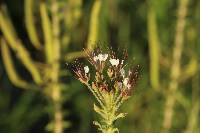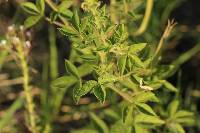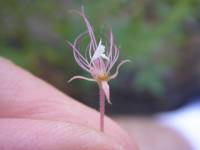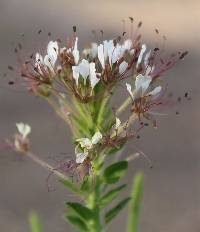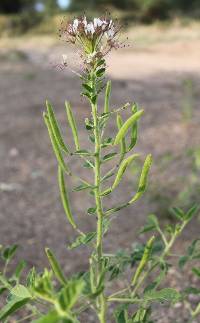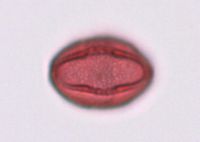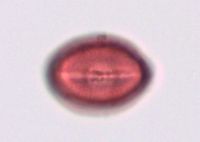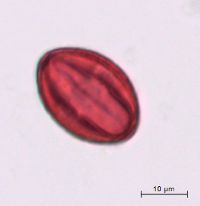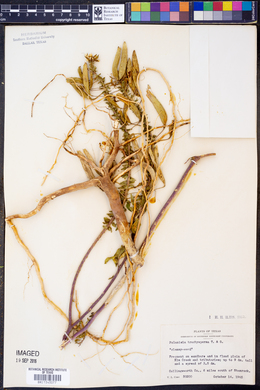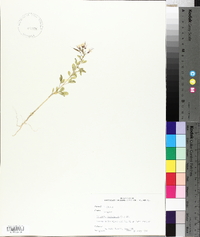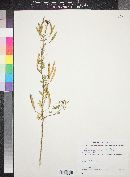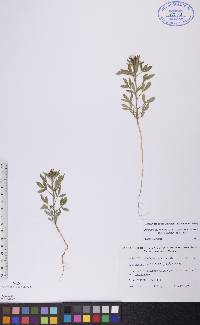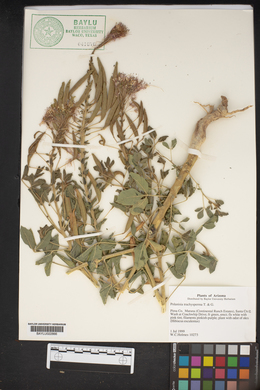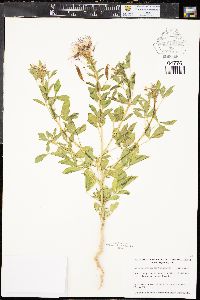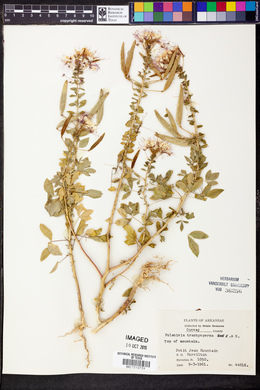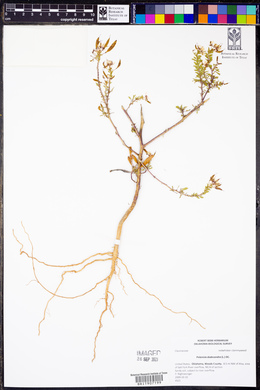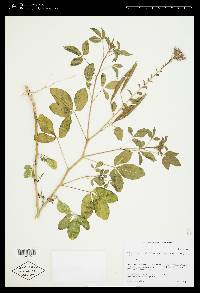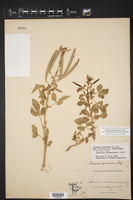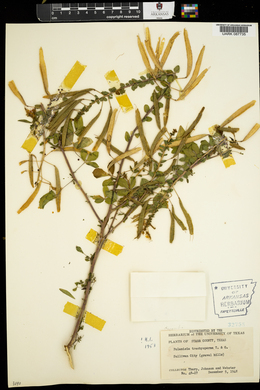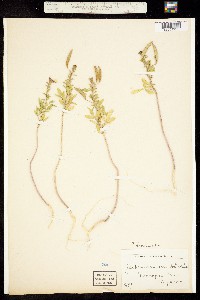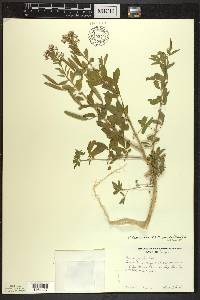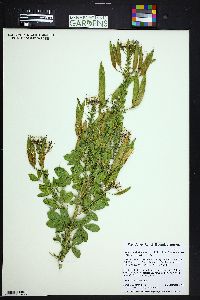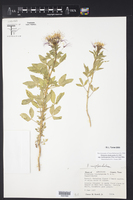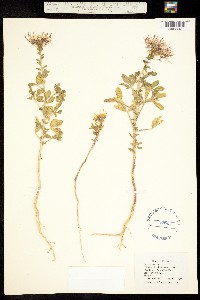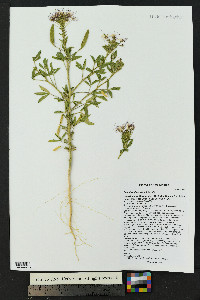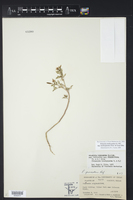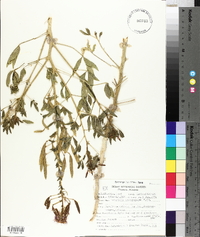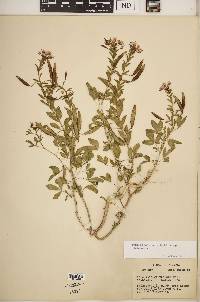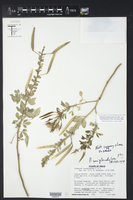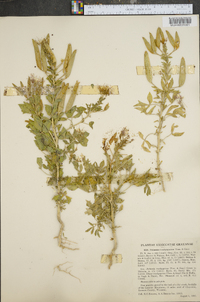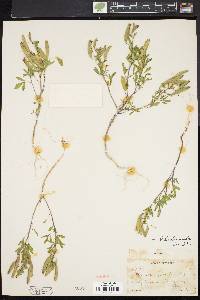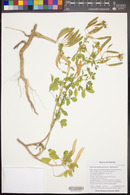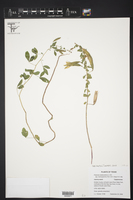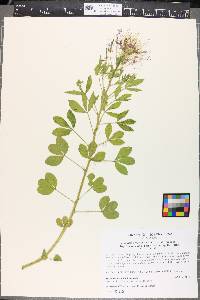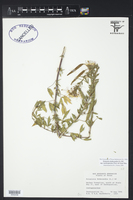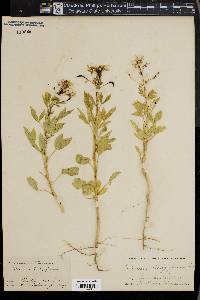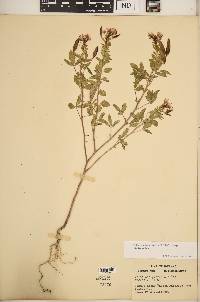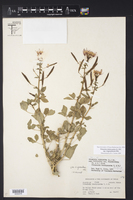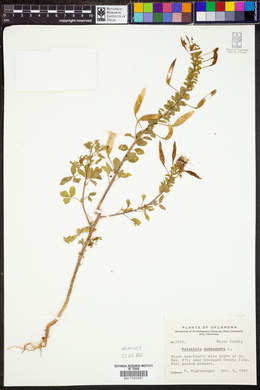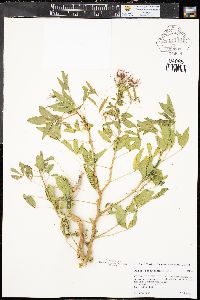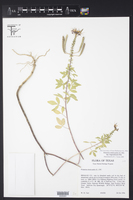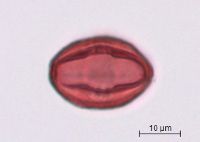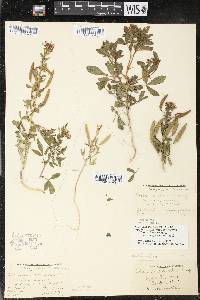
|
|
|
|
Family: Cleomaceae
Red-Whisker Clammyweed, more...western clammyweed, clammyweed, roughseed clammyweed
[Cleome graveolens, morePolanisia dodecandra var. dodecandra] |
Annuals, rarely perennials, (5-)10-60(-90+) cm. Stems branched; hairs stalked, glandular throughout. Leaves: petiole green to purple, angled, 1.5-4.5(-6) cm, glandular; leaflet blade oblanceolate to obovate or broadly elliptic, 1.9-4.5(-6.5) × 0.5-2(-3) cm, margins entire, surfaces sparsely glandular. Racemes (dense) 5-20 cm (10-30 cm in fruit); bracts unifoliate, lanceolate to orbiculate, 5-20 mm. Pedicels 10-25(-40) mm. Flowers: sepals purple, oblong, 3-6 × 1.5-2.5 mm, margins entire, apex acuminate, glandular; petals white, pink, rose, or purple, oblong-ovate, clawed, abaxial pair (3-)5-10 × 1.8-3(-5) mm, apex emarginate to lacerate, adaxial pair 8-14 × 3-5 mm, apex emarginate; nectary glands bright orange, not conspicuous (in fruit); stamens 10-20, exserted, purple, (6-)7-28(-40) mm; anthers purple, 1-1.3 mm; gynophore 0-2 mm in fruit; ovary 5-10 mm; style deciduous in fruit, 5-17 mm; stigma purple. Capsules (inflated) 40-70 × 5-9 mm, reticulate, glandular. Seeds 20-65, dark reddish brown, globose to oblong, 2-2.3 mm, roughened or tuberculate-rugose. Annual herb 20 cm - 0.8 m tall Stem: erect, arching with age, branched, covered with sticky hairs. Leaves: compound with three leaflets (trifoliate), stalked, having an unpleasant odor. Flowers: borne in a many-flowered (fifteen to 30) terminal inflorescence (raceme), each flower subtended by a leaf-like bract and having ten to 27 pink to purplish stamens and a purple style. The four petals are white or pinkish, 3.5 - 16 mm long, with the upper pair being longer than the lower pair, narrowing to a long claw at the base, and deeply notched to squared at the tip. Fruit: an erect capsule, 2 - 7 cm long, 5 - 10 mm wide, oblong, flattened but slightly inflated, with interconnecting veins and stalked glands, opening from the tip to two-thirds the length, releasing fifteen to 40 or more dull reddish to dark brown seeds (1.7 - 3 mm). Leaflets: 1.5 - 6 cm long, 0.5 - 2 cm wide, lance-shaped to widest above middle or lance-elliptic. Similar species: Polanisia dodecandra is represented by two subspecies in the Chicago Region. See links below for further information. Cleome species are distinguished by having six stamens, long-stalked fruit, and petals lacking a notched tip. Flowering: June to October Habitat and ecology: Characteristic along railroads, but also found in disturbed sandy or gravelly soils. Etymology: Polanisia comes from the Greek words polys, meaning many, and anisos, meaning unequal, referring to the stamens. Dodecandra means "with twelve stamens." Author: The Morton Arboretum FNA 2010, Allred and Ivey 2012, Heil et al. 2013 Duration: Annual Nativity: Native Lifeform: Forb/Herb General: Annual herb, 20-80 cm tall; herbage glandular-pubescent, strong-scented. Leaves: Alternate along the stems, on petioles 1-4 cm long; blades compound with 3 distinct leaflets, the leaflets oblanceolate to oval, 1-4 cm long and 3-18 mm wide. Flowers: White, purple, and showy, in terminal racemes; sepals 4, purple-tinged, 4-5 mm long; petals 4, clawed, whitish, 1 cm long; stamens 10-20 per flower, with purple filaments, the longer ones up to 3 cm long, exserted well beyond the petals. Fruits: Capsules long and narrow, somewhat compressed, 2-3 cm long, and generally pointing upward; containing numerous brown seeds, about 2 mm long. Ecology: Found in wash bottoms and other disturbed areas, from 1,000-6,500 ft (305-1981 m); flowers May-October. Distribution: Throughout western North America. Notes: Look for this odd-smelling annual herb in wash bottoms at the low and middle elevations. The flowers are quite distinctive with 4 white petals and many long purple stamens which are longer than the petals and stick out of the flower. The long narrow seed pods are on nearly horizontal stalks, though the seed pods themselves point upwards. The leaves are in sets of 3 oval to oblong leaflets. Appears similar to P. uniglandulosa but that species is perennial; has more stamens per flower (20-30 stamens vs. 10-20 in P. dodecandra); usually has longer stamens (up to 5 cm, vs. 3 cm in P. dodecandra); and has larger flowers (petals 10-30 mm long, vs. petals 8-15 mm long in P. dodecandra). There are 3 subspecies of P. dodecandra: subsp. trachysperma is most common in the southwest. Subsp. dodecandra grows in the midwest and eastern US, but may occasionally occur in the southwest; it has smaller flowers, with petals only 3-8 mm long. Subsp. riograndensis is found in Texas and Mexico, and has pink, rose, or purple flowers. Ethnobotany: Pueblo tribes boil and eat the greens, and sometimes store them for winter use; Zuni use ceremonially. Etymology: Polanisia is from Greek polys, many, and anisos, unequal, referring to the many stamens of various lengths; dodecandra means 12 men, referring to the approximately 12 stamens in each flower. Editor: SBuckley 2010, AHazelton 2017 Stems 2-6+ dm; petioles about as long as the blades; lfls ovate or obovate to lance-elliptic, 1.5-6+ נ0.5-2 cm; fls numerous (15-30 open fls and buds); bracts simple; pet white to pink, irregularly truncate to deeply emarginate; stamens (7-)10-27; nectary solid, 1-2 נ0.5-1.5 mm, with bright orange or orange-red top, inconspicuous in fr; style 3-40 mm, slender, withering and deciduous in fr; frs oblong to narrowly fusiform, flattened but somewhat inflated, mostly 3-6 cm נ5-10 mm, on a stipe 2-6 mm, the valves separating apically for 1/3 to 2/3 their length; seeds mostly 15-40+, 1.7-3 mm; 2n=20. Sandy or gravelly places, especially along streams; N.H. and s. Que. to Alta. and Wash., s. to Md., Tenn., Ark., Tex., and n. Mex. July-Sept. Four well marked vars., 2 in our range: Var. dodecandra, the more northeastern phase, common in our range, has the larger pet 3.5-6.5(-8) mm, and the longest stamens 4-10(-14) mm. (P. graveolens) Var. trachysperma (Torr. & A. Gray) H. H. Iltis, more western, extends e. to Minn. and Mo. and is occasionally intr. eastward; it has larger fls, the larger pet (7-)8-13(-16) mm, and the longest stamens (9-)12-30 mm, usually much exceeding the pet. (P. t.) Gleason, Henry A. & Cronquist, Arthur J. 1991. Manual of vascular plants of northeastern United States and adjacent Canada. lxxv + 910 pp. ©The New York Botanical Garden. All rights reserved. Used by permission. |
|
|
|
This project was made possible in part by the Institute of Museum and Library Services [MG-70-19-0057-19].
Powered by Symbiota

